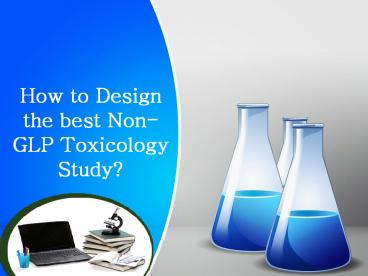Non-GLP Toxicology Study - PowerPoint PPT Presentation
Title:
Non-GLP Toxicology Study
Description:
How to Design the best Non-GLP Toxicology Study? – PowerPoint PPT presentation
Number of Views:111
Title: Non-GLP Toxicology Study
1
How to Design the best Non-GLP Toxicology Study?
2
Toxicology Studies
- Good Laboratory Practice (GLP) is a set of
standards for conducting toxicology studies. They
define how these studies must be planned,
performed, monitored, recorded, reported, and
stored for future reference. - However, not all toxicology studies require compli
ance with the GLP standards. Basic screening
tests where the safety of the product is not
assessed do not require GLP compliance.
3
- Non-GLP never indicates complete ignorance of the
GLP standards, its only that few standards may
not apply to these studies. - Nevertheless, non- compliance with the GLP
standards doesnt mean you design your study
poorly. - Even Non-GLP studies should be carried out in a
way that reflects the clinical settings, ensures
the accuracy of the results and maximise your
return on investment.
4
Here we provide you with some quick tips to
design the best and effective Non-GLP toxicology
study
5
1) Make sure you use an appropriate species
- Generally, you need two animal species to test
the safety profile of a drug and one species for
biologic. Make sure you fulfill this basic
requirement in your study. - Further, preliminary studies to identify and
confirm that the pharmacological activity is the
same as in humans should be completed
before animal testing.
6
2) Choose the right dose or doses of your drug
- The science of toxicology is based on the simple
principle, a relationship between the animal
response and the amount of drug dose received. - Toxicology studies are designed to investigate
how animals react to the doses from low to high
levels. The animals are examined at specific
intervals for the presence or absence of drug
effects such as clinical signs, changes in
behavior, alterations in serum chemistries, or
effects on organs and organ systems. - However, to ensure you observe these effects in
your toxicology studies, choose the recommended
doses of drugs.
7
3) For NOAEL, choose a dose with similar exposure
- NOAEL means No observable adverse effect
level and is used to define the starting dose of
the drug in clinical trials. - If you wish to define NOAEL with your study,
choose a dose that result in a similar exposure
as the estimated clinically relevant dose. - Doses higher than this will produce toxicity.
8
4) Make your study Informative
- What is the main purpose of a toxicology study?
- Of course, to define a safe clinical dose. But,
if you think Non-GLP studies cant accomplish
this, you are mistaken. - Non-GLP toxicology studies are preliminary but
can be extremely informative. If designed
appropriately, their results can explain the
mechanism behind the suspected toxic effect. - Also, they can tell the right dosing and whether
there is an acceptable safety margin to send the
drug for further trials.
9
- Non-GLP toxicology studies should mimic the
clinical setting as far as possible as the length
of dosing, route of administration, the frequency
of dosing, etc. - You must also include the ways to monitor safety
pharmacology measure blood pressure, scan the
liver and monitor any hyperglycaemic /
hypoglycaemic events.
10
If you follow these tips with perseverance, you
can make out the most of your non-GLP toxicology
study.
11
Contact Us
- Email ID project_at_cognibrain.com
- Phone 044-49595223
- Visit us https//www.cognibrain.com/































